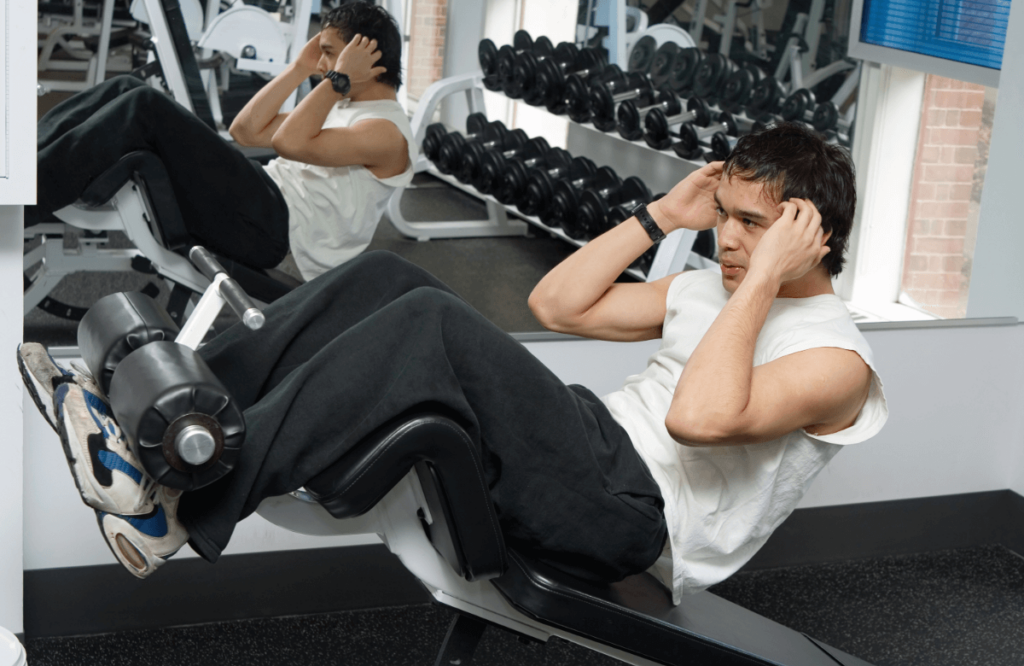With a strong core, everything from gymming to reaching when you drop the remote on the floor is easier and safer. But if you’ve got a weak core, you’re susceptible to injury not just when exercising, but in everyday life.
If you’re after ab aesthetics, then you can exercise all you want, but diet should be your number one focus for stripping body fat. But if you’re after abdominal strength as well as washboard abs, then weighted core exercises are going to be your best friend.
And one of the staples in a well-rounded core workout is cable crunches. Forget pumping out hundreds of sit-ups—this weighted ab exercise will get those chocolate blocks working hard.
Jump to:
What Are Cable Crunches?
Cable crunches, also known as cable machine crunches or rope crunches, are one of Arnold Schwarzenegger’s favorite ab exercises. Need I say more? It’s a weighted kneeling crunch movement done on the cable machine, and it’s a highly effective exercise for building a tough core.
Why Are Cable Crunches Effective for Building a Strong Core?
The biggest benefit of cable crunches is that you can progressively overload your entire rectus abdominis muscle—also known as the six-pack ab muscle! This is next to impossible on exercises done without weight, because even adding more reps just leads to fatigue, not progressive overload.
They’re also an exceptionally stable abdominal exercise, so as long as you’re focusing on proper form, it’s hard to do them wrong and NOT activate the abs! Between the stability of the exercise and its excellent potential for progression, it should be a staple in everyone’s ab workout.

Cable Crunches vs Traditional Crunches: Which Is Better?
Cable machine crunches have certain advantages over regular crunches. While you can do normal ol’ crunches any time, anywhere, with just a floor and your bodyweight, they do have limitations.
One of the worst things about traditional crunches is that they can place a lot of strain on the neck and lower back, especially if you have a weak core. Beginners often start with regular crunches, but cable crunches can actually be a better choice because it takes away that strain, although you still need to make sure you’re doing them with good form.
It’s also easy for other muscles to take over during standard crunches, so your form can get lost pretty easily and you might not even be activating your abs as much as you think. The same isn’t true for cable crunches—as long as you’re using proper technique and a decent amount of weight, you’ll definitely activate those abs.
While traditional crunches are convenient if you find yourself without a gym, we really recommend adding cable crunches to your routine instead of the regular ones whenever possible.

Benefits of Cable Crunches
Not sure about cable crunches? Here are some of the benefits you’ll get if you add them to your regular ab workout routine.
Excellent Strength Builder
A major benefit of cable crunches is that they’re a fantastic core strength builder. Unweighted ab workouts do get the muscle moving and in some cases, use your body weight, but with the addition of weight to your crunch movement, you can expect to build a stronger core.
Safe Way to Go Heavy
Here we come back to progressive overload. This principle is how bodybuilders pack on the muscle and build strength at the same time, but it can be super hard to do on abs. The cable machine is the perfect exercise for adding weight in a safe, stable way so you can see continual progress.
Easy Weight Increase
Some ab exercises are almost impossible to add weight to. Holding a dumbbell between your feet for leg raises can only go so far before it becomes hard to add more without being extremely uncomfortable, and not everyone has access to ankle weights or similar tools.
With the cable machine, it’s as simple as shifting that pin up on the weight stack. Quick, easy, and no-fuss, which is how we like our exercises!
Increased Mind/Muscle Connection
We particularly love the mind/muscle connection with this ab exercise. To really activate those abdominals, you have to focus on the muscles contracting, which builds the connection between your muscles and your brain.
Not only does this serve you well in all exercises, but in this exercise it can help to stimulate more abdominal muscle growth and build more strength.

How to Do Cable Crunches
Learning how to do cable crunches properly isn’t hard, but it’s essential to help you get the biggest benefits out of the exercise. Here’s what you need to know to make sure you’re using the proper exercise technique.
Set-Up
The cable pulley needs to be set at its highest setting for this exercise. Use a cable rope attachment to help you get the best range of motion.
Some personal trainers will tell you to stand facing the cable machine, while others will tell you to stand with your back to it. What you choose really depends on your personal preference, and might also change depending on the cable machine you’re using and the space.
Grab the attachment with both hands and unrack the weight, then take a step away from the machine. From here, kneel on your knees. Generally, you want your knees about hip-width apart and the underside of your toes in contact with the floor, but find a stance that feels stable to you. An exercise mat or foam pad is a good idea here.
From here, hinge at the hips slightly and tuck your chin under. Position your hands in front of your head, so your thumbs are touching your hairline.
Unlike almost every other exercise, the key to getting this one right is to round your back. Don’t just hunch though—you want to tighten your core, creating a “hollow body” position. This is your starting position for the cable crunch.
Doing the Cable Crunch
Now for the actual movement. From the original position, squeeze your abdominal muscles and bring your elbows down towards your knees. Make sure your hips stay as still as possible throughout the movement, and don’t push your butt backwards!
Also make sure you’re not pulling with your arms as you come down. Your arms also should stay as still as possible—you’re simply bringing your torso downwards and maintaining a hold on the ropes with your arms and hands.
Return to the Starting Position
An essential part of cable crunches form is how you return to the starting position. At the bottom of the movement, hold it for a moment as your core is tight. Then, allow the weight of the rope to bring you back up slowly, while maintaining the tightness in your core.
DO NOT just let the tension go and come up using the weight of the rope. Technically, you’re working against the pull of the rope, which is extremely valuable—do it in a controlled movement or you’ll miss out on half the benefit of this exercise.

Variations of Cable Crunches
If kneeling on the floor for a standard cable crunch isn’t an option for you, there are plenty of cable crunches alternative versions. They’re all technically the same exercise, but in a variety of different ways so everyone can find an effective variation.
Standing Cable Crunch
If you’ve got knee issues, you can still enjoy the benefits of this exercise, just standing instead of kneeling. You can stand with your glutes against the bar, facing away from the cable machine, which will add a touch of torso stability.
If you’d prefer to face the machine, the key to stability is to get your upper body at a similar angle to what it would be during a kneeling crunch.
Grab the ropes, take a step or two back so there’s plenty of tension in the rope, plant your feet, and hinge at the hips at around a 45-degree angle. Hold the rope just in front of your head with your chin tucked, and tighten your core as if you’re receiving a punch. This is your starting position.
From there, squeeze your core and bring your elbows down to your thighs. Again, keep your hips stable and your arms as still as possible. The only thing that should be moving is your entire torso, hinging at the hips.
Kneeling Oblique Cable Crunch
If you want to target those obliques a little more, you can try this variation. You can set yourself up exactly as you would for a normal cable crunch, and instead of bringing your elbows down towards your two knees, bring both elbows down towards the same knee.
Alternatively, you can do these with just one hand holding the rope. Make sure you maintain good form with these, because it can be easy to go wrong. In this case, you’ll bring the arm down to the opposite knee, and you’ll feel that crunch in the oblique.
Machine Crunch
Most gyms have an abdominal crunch machine, so it’s a common variation. Some have pads that come right over the shoulders and lock nicely into place, and others simply have handles that you have to grab and grip.
Either way, remember that most of the movement should be done by tensing your core, NOT pulling with your arms or shoulders. Take care not to push too hard with your feet against the foot pads, either—this is simply to keep you stable.
Also remember to actively work against the weight as you come back up. Don’t neglect this part of the exercise—this is where muscle gains are made!
Decline Bench Sit-Up
If you’ve got no access to a cable station, a decline sit-up is a good alternative to a regular crunch. On a decline bench, you’ll be able to hook your feet under the foot pads for stability, but again, make sure you aren’t pulling yourself up and disengaging your core.
Remember to keep your chin tucked and maintain a hollow-body position by keeping your core tight throughout the movement, not just on the upswing. It’s a classic bodyweight exercise, but if you want to add weight to these, we recommend a weight vest, as you can add more and more as you become stronger.

Common Mistakes to Avoid
Like all exercises, there are certain mistakes that are easy to make when doing the cable crunch. While it’s safer than other crunch versions when done correctly, keep an eye out for these errors and make sure you’re avoiding them.
Arching Your Back
Now this can be a little tricky. While you should be rounding your back slightly to achieve that hollow-body position, you shouldn’t be hunching over, especially in the mid- to lower back. This can easily lead to injury that can sideline you for weeks.
And you definitely shouldn’t be doing the opposite—arching your back the other way, in an attempt to “keep it straight”. You can combat this by remembering to keep your abs tight and make your body hollow.
Swinging Your Arms or Body
Momentum is the enemy of muscle growth. Every movement should be slow and controlled; if you have to swing to get the weight down, then you’re using too much weight.
Keeping your arms and hips as stationary as possible is one of the biggest challenges of this exercise, but it’s the only way to do it with correct form. Rather do these reps overly slowly so you can feel your ab muscles working and make sure you aren’t using the wrong parts of your body to shift the weight.
Using Too Much Weight
Although you can go nice and heavy on this exercise, using too much weight means you won’t get the full benefit of the movement. Your other muscles will end up needing to join in to help you move the weight, which defeats the point of the exercise.
Plus, trying to move too much weight means there’s a high chance of your form going out the window, so injury will always be just a movement away. Stick to a weight that you can crunch with perfect form for 4 reps (guys) or 8 reps (girls).
Once you can lift that same weight or 6 (guys) or 10 reps (ladies), you can increase to a slightly heavier weight that you can lift once again for 4 or 6 reps. Go through the whole cycle again, increasing in weight every time you reach the higher end of the rep range with perfect form.
Using Too Little Weight
On the flip side, if you use too little weight, you won’t be getting the full muscle-engaging benefit of this movement. If you can do 6 reps for guys or 8 reps for women with great form and still get more in, you’re using a weight that’s too light.
You need to challenge the muscles enough for them to actually grow. Stick to the rep range mentioned above, and you’ll always have a pretty good idea of what weight you should be using.
Not Engaging Your Core
Yes, this happens—doing core exercises without actually engaging your abs! It’s particularly problematic if you’ve got strong shoulder and bicep muscles, because when the core muscles fatigue, these are likely to take over.
Be extra mindful about whether or not your core muscles are actually engaging. If you discover that your arms are doing most of the work, then choose a lighter weight. Keep your attention firmly on your core (remember the mind/muscle connection) and make sure it’s working during the movement.















